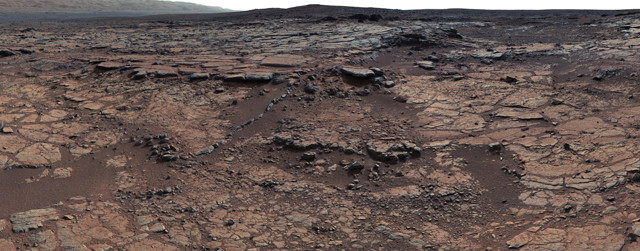
by Timothy Oleson Wednesday, May 17, 2017

Although Curiosity has found ample evidence that water flowed long ago on Mars' surface, the rover has found no signs of carbonate rocks in its travels through Gale Crater, including at Yellowknife Bay (seen here), suggesting that ancient Mars had much lower atmospheric carbon dioxide levels than previously thought. Credit: NASA/JPL-Caltech/MSSS.
With two rovers patrolling the surface of Mars, six spacecraft orbiting above it, and scientists here on Earth studying the Red Planet from afar, new findings are announced often. Here are a few of the latest updates.
Carbon dioxide levels in Mars’ atmosphere 3.5 billion years ago were far too low to provide the warmth needed to explain the presence of flowing water on the planet’s surface around that time, according to new research in Proceedings of the National Academy of Sciences. With the ancient sun only about two-thirds as intense as it is now, an atmosphere thick with carbon dioxide has been the leading explanation for how the now-frigid planet could have maintained liquid water on its surface long ago. But in its surveying since 2012 of bedrock in 3.5-billion-year-old Gale Crater, where plenty of physical evidence of formerly flowing water has been seen, the Curiosity rover has found no signs of carbonate rock. Considering this lack of carbonates, carbon dioxide concentrations must have been tens to hundreds of times lower than those required, according to climate simulations, to warm early Mars enough to maintain surface water, reported Thomas Bristow of NASA’s Ames Research Center in California and colleagues. The findings, they wrote, “imply that other mechanisms of warming Hesperian Mars, or processes that allowed for confined hydrological activity under cold conditions, must be sought.”
Unlike on Earth, scientists can’t collect ice cores on Mars to study how or why ice deposits formed, or to reconstruct past climates. In a new study in Geophysical Research Letters, however, researchers used imagery from the High Resolution Imaging Science Experiment on the Mars Reconnaissance Orbiter (MRO) to assemble “virtual ice cores” of the Red Planet’s layered north polar ice cap, allowing the researchers to peer into the history of the kilometers-thick ice. The ice cap, thought to have been accumulating over the past 4 million to 5 million years, is lined with troughs and canyons that, like roadcuts, expose numerous layers deposited sequentially through time. With the high-resolution satellite imagery, Patricio Becerra of the University of Arizona and colleagues could clearly discern distinct layers based on differences in the topography and brightness of the ice. Using the resulting virtual cores, the team then found that patterns in the ice layering correlate with periodic changes in Mars’ orbit and tilt, which determine the amount of solar radiation the planet receives and are thus a dominant driver of climate. A link between Mars’ orbital parameters and ice layering had been theorized since the early 1970s, after Mariner 9 first observed the polar cap, but clear observational evidence had been lacking until now.
In a new study of the Elysium Volcanic Province — Mars’ second-largest volcanic complex after the Tharsis Province, which includes Olympus Mons — researchers detail geochemical variations among lava flows both within the province and between Elysium and elsewhere on the planet that, they suggest, offer new insights into volcanic evolution on the planet. Using data from Mars Odyssey and MRO, David Susko, a graduate student at Louisiana State University, and colleagues quantified elemental abundances in ancient lavas in the northwest and southeast regions of Elysium. They found, for example, that the southeast region — which, based on crater counting, is about 850 million years younger than the northwest region — has elevated levels of iron, whereas the northwest is relatively enriched in thorium. Overall, the researchers suggested in Scientific Reports, the patterns of variation observed are more consistent with mantle sources of erupted magmas varying over time, rather than with the eruption of uniform magmas followed by later alteration by water, which had been proposed previously. Specifically, they wrote, “the geochemistry seems most consistent with a model for the change in the depth of melt formation in the mantle beneath the Elysium Volcanic Province” through time.
© 2008-2021. All rights reserved. Any copying, redistribution or retransmission of any of the contents of this service without the expressed written permission of the American Geosciences Institute is expressly prohibited. Click here for all copyright requests.